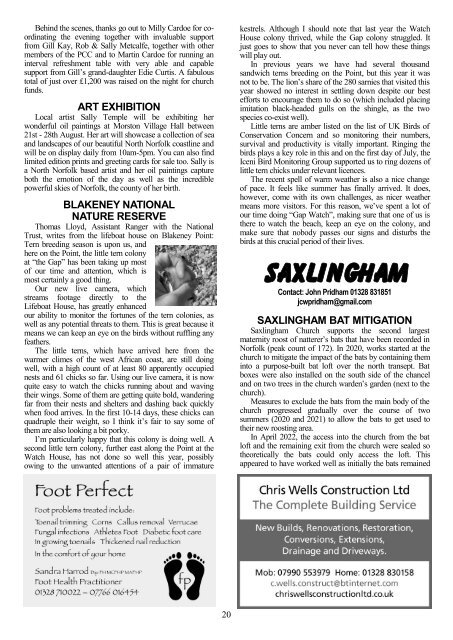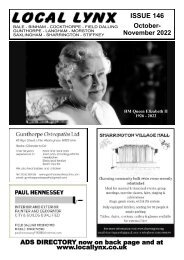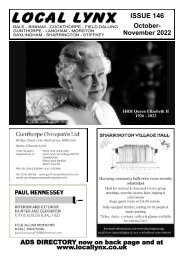Local Lynx No.151 August/September 2023
The communty newspaper for 10 North Norfolk villages.
The communty newspaper for 10 North Norfolk villages.
Create successful ePaper yourself
Turn your PDF publications into a flip-book with our unique Google optimized e-Paper software.
Behind the scenes, thanks go out to Milly Cardoe for coordinating<br />
the evening together with invaluable support<br />
from Gill Kay, Rob & Sally Metcalfe, together with other<br />
members of the PCC and to Martin Cardoe for running an<br />
interval refreshment table with very able and capable<br />
support from Gill’s grand-daughter Edie Curtis. A fabulous<br />
total of just over £1,200 was raised on the night for church<br />
funds.<br />
ART EXHIBITION<br />
<strong>Local</strong> artist Sally Temple will be exhibiting her<br />
wonderful oil paintings at Morston Village Hall between<br />
21st - 28th <strong>August</strong>. Her art will showcase a collection of sea<br />
and landscapes of our beautiful North Norfolk coastline and<br />
will be on display daily from 10am-5pm. You can also find<br />
limited edition prints and greeting cards for sale too. Sally is<br />
a North Norfolk based artist and her oil paintings capture<br />
both the emotion of the day as well as the incredible<br />
powerful skies of Norfolk, the county of her birth.<br />
BLAKENEY NATIONAL<br />
NATURE RESERVE<br />
Thomas Lloyd, Assistant Ranger with the National<br />
Trust, writes from the lifeboat house on Blakeney Point:<br />
Tern breeding season is upon us, and<br />
here on the Point, the little tern colony<br />
at “the Gap” has been taking up most<br />
of our time and attention, which is<br />
most certainly a good thing.<br />
Our new live camera, which<br />
streams footage directly to the<br />
Lifeboat House, has greatly enhanced<br />
our ability to monitor the fortunes of the tern colonies, as<br />
well as any potential threats to them. This is great because it<br />
means we can keep an eye on the birds without ruffling any<br />
feathers.<br />
The little terns, which have arrived here from the<br />
warmer climes of the west African coast, are still doing<br />
well, with a high count of at least 80 apparently occupied<br />
nests and 61 chicks so far. Using our live camera, it is now<br />
quite easy to watch the chicks running about and waving<br />
their wings. Some of them are getting quite bold, wandering<br />
far from their nests and shelters and dashing back quickly<br />
when food arrives. In the first 10-14 days, these chicks can<br />
quadruple their weight, so I think it’s fair to say some of<br />
them are also looking a bit porky.<br />
I’m particularly happy that this colony is doing well. A<br />
second little tern colony, further east along the Point at the<br />
Watch House, has not done so well this year, possibly<br />
owing to the unwanted attentions of a pair of immature<br />
kestrels. Although I should note that last year the Watch<br />
House colony thrived, while the Gap colony struggled. It<br />
just goes to show that you never can tell how these things<br />
will play out.<br />
In previous years we have had several thousand<br />
sandwich terns breeding on the Point, but this year it was<br />
not to be. The lion’s share of the 280 sarnies that visited this<br />
year showed no interest in settling down despite our best<br />
efforts to encourage them to do so (which included placing<br />
imitation black-headed gulls on the shingle, as the two<br />
species co-exist well).<br />
Little terns are amber listed on the list of UK Birds of<br />
Conservation Concern and so monitoring their numbers,<br />
survival and productivity is vitally important. Ringing the<br />
birds plays a key role in this and on the first day of July, the<br />
Iceni Bird Monitoring Group supported us to ring dozens of<br />
little tern chicks under relevant licences.<br />
The recent spell of warm weather is also a nice change<br />
of pace. It feels like summer has finally arrived. It does,<br />
however, come with its own challenges, as nicer weather<br />
means more visitors. For this reason, we’ve spent a lot of<br />
our time doing “Gap Watch”, making sure that one of us is<br />
there to watch the beach, keep an eye on the colony, and<br />
make sure that nobody passes our signs and disturbs the<br />
birds at this crucial period of their lives.<br />
SAXLINGHAM<br />
Contact: John Pridham 01328 831851<br />
jcwpridham@gmail.com<br />
SAXLINGHAM BAT MITIGATION<br />
Saxlingham Church supports the second largest<br />
maternity roost of natterer’s bats that have been recorded in<br />
Norfolk (peak count of 172). In 2020, works started at the<br />
church to mitigate the impact of the bats by containing them<br />
into a purpose-built bat loft over the north transept. Bat<br />
boxes were also installed on the south side of the chancel<br />
and on two trees in the church warden’s garden (next to the<br />
church).<br />
Measures to exclude the bats from the main body of the<br />
church progressed gradually over the course of two<br />
summers (2020 and 2021) to allow the bats to get used to<br />
their new roosting area.<br />
In April 2022, the access into the church from the bat<br />
loft and the remaining exit from the church were sealed so<br />
theoretically the bats could only access the loft. This<br />
appeared to have worked well as initially the bats remained<br />
20
















